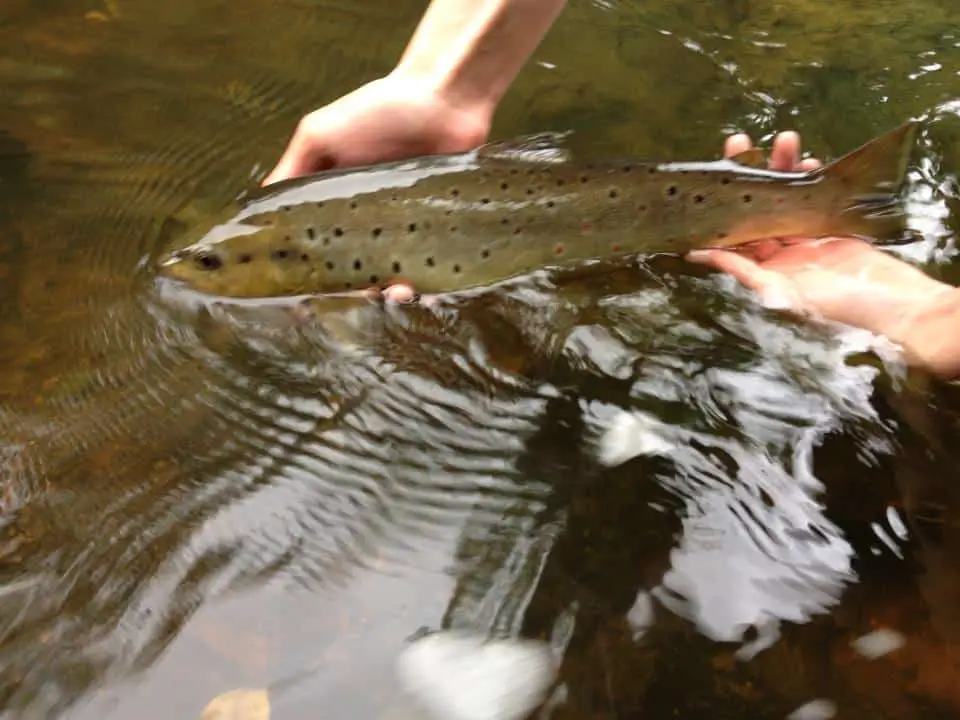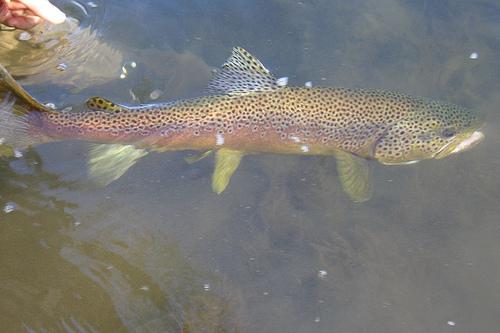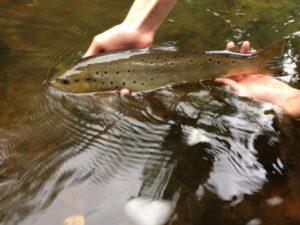This post was last updated on August 14th, 2021 at 08:46 pm
These Tips Will Help You Catch and Release Your Trout Unharmed

Why Practice Catch and Release?
Fact is, the larger the fish is, the more tempting it is to keep, but those big fish are needed in the ecosystem to reproduce. The larger the trout, the greater the quantity of eggs it lays. In a wild trout fishery we need all of these big fish to sustain the amount of sportsman going after them. They may be a renewable resource, yet they are not that renewable. With the amount of habitat loss and ever increasing angler population, I would say if each fisherman kept one trout each trip, the rivers would be in great danger.
These days there is an ever increasing lack of budget for fisheries. Most people cannot afford healthcare, a significant amount of people are living off of government assistance. Most states cannot afford to feed the welfare recipients, how are they going to repopulate the trout that the ever increasing populations are killing? Notice the amount of fish when you go into western states to fish. This didn’t happen by accident, and it’s likely not just nature. Western flyfishers have been practicing catch and release for years. The greatest reason that fishing is better in that part of the world is not because there are more insects for the fish, not entirely because of stream quality, it is because people let fish go. Plain and simple..
Proper Catch and Release Tips – Wet Your Hands Before Touching Fish
Trout are not typically the most hardy fish. If you plan to release the fish be sure to wet your hands prior to touching it. By touching the fish out of water, and with a dry hand—you are removing the protective slime from the surface of the fish. This slime is a barrier on the exterior of the fish to keep bacteria and fungus out. If this slime is removed the fish will very likely die of a fungus.
Most of us have had fish tanks while we were growing up. Do you remember that white growth that would form on the fish once in a while? If you recall the fish would inevitably end up dead without treatment almost immediately. Well.. these trout don’t have anyone to provide them with medication. A very easy way to wet your hands is by tapping them on the bottom of your net. This is especially helpful when you are fishing from a high sided driftboat, or a tipsy canoe. This one small step requiring minimal effort from you can go a long way to save a trouts life during your catch and release fishing trips.
Fight Your Fish Quickly and You could Save It’s Life
Sometimes people like to use light tippets and thin fishing line. Everyone knows trout are line shy right?
 Well, maybe they aren’t as line shy as a lot of people think. Especially if you are casting streamers or throwing hardware at them (also called lures) Some of the time you actually do need to use light line in order to get them to hit. We’ll say they are eating trico’s also called tricorythodes (a very small mayfly) you will likely need 6x to even get the line through the eye of the hook. Anyway my point is that oftentimes by deciding to use small rods and light line, you are choosing to put the fish under a long fight to land it.
Well, maybe they aren’t as line shy as a lot of people think. Especially if you are casting streamers or throwing hardware at them (also called lures) Some of the time you actually do need to use light line in order to get them to hit. We’ll say they are eating trico’s also called tricorythodes (a very small mayfly) you will likely need 6x to even get the line through the eye of the hook. Anyway my point is that oftentimes by deciding to use small rods and light line, you are choosing to put the fish under a long fight to land it.
Catch and release fisherman should know, the faster you land the fish, the better it’s chances for survival. If you are using a size 2 grasshopper or a streamer you can pull that fish in FAST. Don’t be a baby and get owned by the fish. You aren’t trying to fight the fish to death! I might sound a little harsh here, but I have good reason to (in my opinion) I spend almost 100 days guiding each year. A vast majority of people take it a little too easy on the fish. Maybe they are enjoying the fight, or maybe they are trying to be careful and not lose the trout. Whatever the case might be, if you are planning to practice catch and release, fight your fish quickly and prevent over exhaustion.

Reviving your catch – How to help a struggling trout survive after you catch it
Lets say that circumstances beyond your control have caused your fish to not swim off. Or maybe you just fought it to the point of severe exhaustion. If your fish is not doing so good when you attempt to release it, there are a couple measures you can take.
You will want to keep your trout facing upstream and gently move it back and forth with a fairly firm grip at the base of it’s tail. By doing this technique, you are forcing water over its gills and providing much needed oxygen to it. I have spent upwards of ten minutes reviving fish that were overworked in a fight. Using this strategy you can almost always get the fish going again. If by chance your fish has taken an injury to its gills and is bleeding badly, it will probably not survive. I have seen the blood stop before and the fish swim off looking as good as ever, but I don’t think it happens very often. If you have realized that the fish is dead or will certainly die, then you might as well “klunk” it over the head and throw it in the cooler. Even if you don’t like to eat fish, I am sure you can find someone at the boat launch who does. Maybe a neighbor? There is no sense releasing a trout that has no chance of survival.
Use Barbless Hooks
Barbless hooks are much safer for the trout when it comes time to remove them. If you hook the fish in a sensitive area, a barbless hook will pull right out and increase it’s chance for survival. They will also be easier on you if you ever happen to put a hook in your body.
Use a Soft Net for Landing Trout

You know those cheap nets that you can buy at any big box store? The ones that feel like sandpaper against your skin? Those nets KILL fish! If you get a big trout in one of those nets it will twist and turn like heck; Often times to the point of tearing the scales off the fish. Trout are a delicate species! Its OK to use those nets on musky and pike, they will be fine because of their tough skin. Trout however are a delicate species. They make nice soft cloth nets specifically for the gentle touch of a kind fisherman like you. There are also many styles of rubberized nets. These are the best for not harming fish for catch and release. Rubber nets tend to break fairly easily after a few years of heavy use, but in the end it ends up being worth using them.
Another benefit to a rubber landing net for trout, is that your hooks will not lodge in the netting material—making the hooks very easy to quickly remove. This can be a real bonus when you are fishing with a multiple fly rig.
Give Your Trout Some Air
When you catch a large trout it is very exciting. Often times adrenaline, testosterone, and all sorts of manly fluids are pumping through your body. Its easy to forget that while you and your buddy’s are high fiving, and taking pictures that your trout has been out of the water probably too long! Chances are if that trout has been out of the water for more than a minute it will likely end up dead. It might swim off fine, it probably will.. But its likely hood of living is slim. All you need to do is keep the fish in the net immersed in the water while your cameraman is getting ready for the shots. Lift the fish out of the water, take the picture and put it back. If you decide you need more shots from a different angle because the sun was wrong, then leave the fish in the water during the adjustment. This is another simple step that can help you keep your trout safe while practicing catch and release.
Conclusion – How to properly catch and release trout
With the current amount of fisherman on our lakes and streams, it is more important than ever to release your trout and treat them with care. Many areas in the United states have only natural reproduction. By releasing and treating trout properly, you are helping to preserve the valuable resource. These trout don’t grow large over night. It takes many years, and a huge amount of luck for an individual trout to survive to adulthood. Show your trout, and fellow anglers respect. The trout deserve it and you will be helping to make fishing in your local rivers better for many generations to come. Practicing catch and release is one thing you can do to directly help out the trout anglers of the future. Hopefully this article tells you everything you need to know about how to properly catch and release trout.


